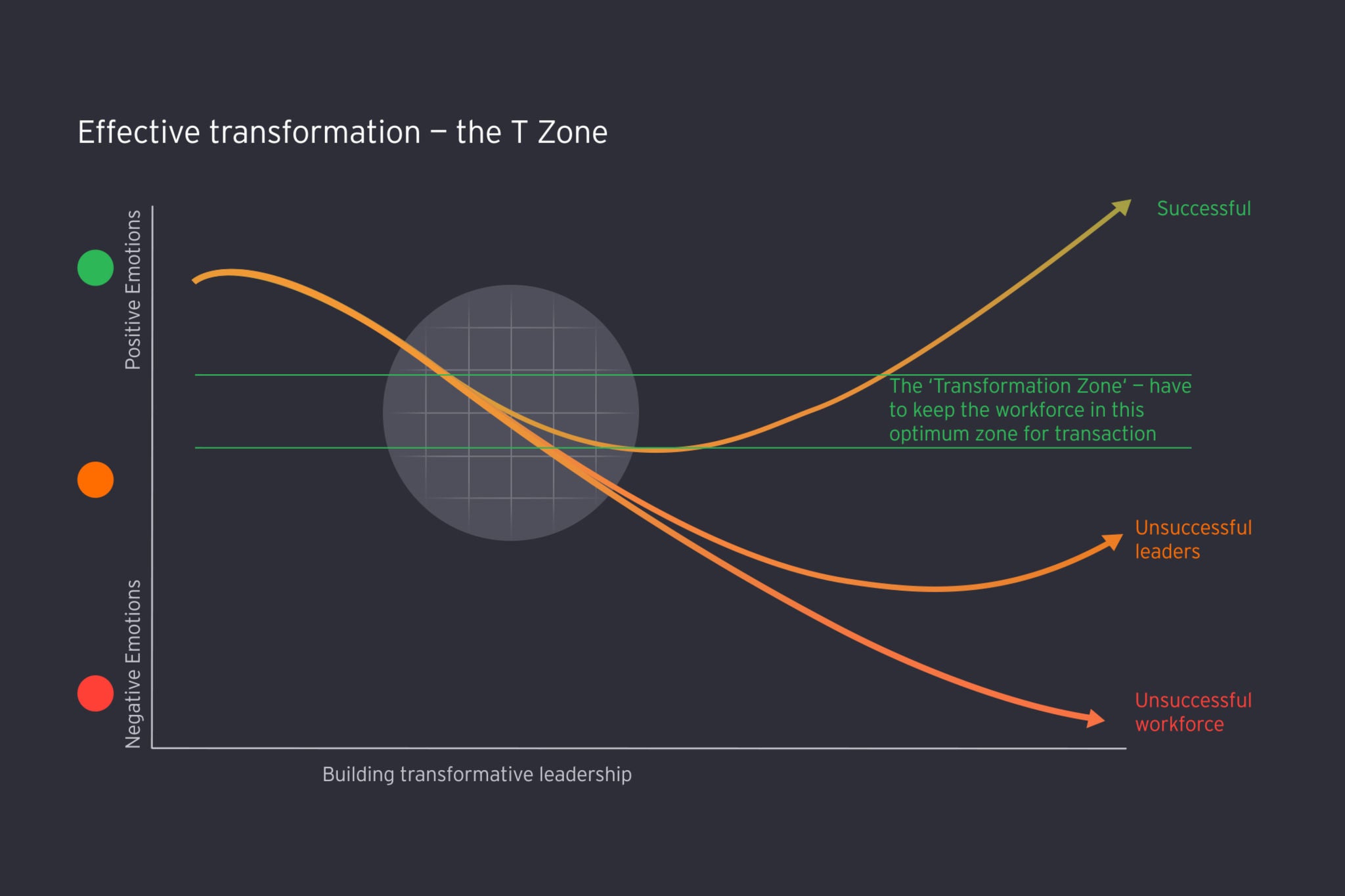3. Lead: Adapt and nurture the necessary leadership skills
Whether it comes naturally, CEOs and transformation leaders will need to show that they care, that they are walking the talk with respect to the vision, and that they are present and show up, particularly when the going gets tough. Teams also need to show that they are in it together – and are aligned behind the transformation. The workforce is looking for a strong and coherent voice from leadership.
Leaders tend to be more aligned during a crisis. CEOs and transformation leaders will want to use this to their advantage to get buy-in early from senior executives and management. In successful transformations, leaders (41% versus 34% in underperforming transformations) were united on how to achieve the vision.
The key difference between successful and underperforming transformations was the actions of leaders. In the crucible of transformation, technical expertise is less important than human emotion and empathy.
Key action: Listen intently and be open to everyone’s opinion, demonstrate that you are listening by showing up, align leadership around the vision, and be emotionally present and supportive, particularly when workers are struggling.
4. Empower: Set clear responsibilities and be prepared for change
Transformations are not linear journeys. There are ups and downs, twists and turns. This is why it is so important for leaders to provide both structure and discipline, as well as the freedom to be creative, explore and innovate. Get people involved by co-creating and defining clear roles in the transformation. People need to feel a sense of agency and see that they are part of the solution, rather than being hit by forces beyond their control. In successful 2020 transformations, workers said they were assigned clear roles and responsibilities (46% versus 37% in underperforming transformations).
Further, in successful transformations, the organization’s culture encouraged innovation and new ways of thinking. Leaders need to harness the power of the people within the organization to problem-solve and crowdsource novel solutions to key challenges.
Key action: Get clear on roles and responsibilities (delegate decision rights where you can) and nurture a culture of experimentation. Engage everyone in innovating solutions.
5. Build: Use technology to demonstrate quick wins and build momentum for the transformation
Technology doesn’t equal the vision. Rather, it can help bring the vision to life. Leaders will want to use technology to quickly breathe life into the future through automation, artificial intelligence (AI), digital and data. Technology will need to be closely tied to the stated vision and properly funded to maximize success. In successful 2020 transformations, respondents said that their organization deployed the right technology to execute the transformation (47% versus 39% in underperforming transformations).
It’s also important to link the new technology to organization and workforce of the future. Change is scary. With the right investment in learning and by bringing emotional support, leaders can shift the fear to excitement as workers build a digital mindset and skillset. In successful 2020 transformations, respondents said that their organization had the digital skills and mindset needed for transformation (48% versus 42% in underperforming transformations).
Key action: Tie technology to the vision and properly fund it; invest in skills and mindsets, providing the right learning to foster a digital mindset and skillset.
6. Collaborate: Find new way to connect and co-create
Throughout the pandemic, most organizations shifted to radically new ways of working almost overnight. They did it by taking risks, innovating and co-creating new ways of collaborating and working. They were constantly talking and listening to their workforce – co-creating as they went. This is key to human-centered transformation. CEOs and transformation leaders will want to create an organizational climate that fosters connectivity, collaboration, and creativity, all in support of the vision. In successful 2020 transformations, respondents said their culture encouraged innovation and new thinking (43% versus 36% in successful transformations prior to 2020), indicating that collaboration is of heightened importance in times of a downturn.
Leaders will also want to create two-way dialogue and work with their workforce to define future ways of working. A quick way into this is to identify influencers across the organization to get a strong understanding of the current mood of the organization and what leaders need to do to keep it moving forward.
Key action: Bring the workforce into the process and co-create future ways of working.
Transformation is the new normal
The twin challenges that organizations currently face – of reshaping and taking costs out while simultaneously investing in the organization of the future to attract and retain key talent – offer a great example of the paradoxes that will be part of a hyper turbulent age.
For the foreseeable future, organizations will be in a constant state of flux and transformation. How CEOs deliver transformation will become a strategic differentiator. Those that successfully deliver transformation will push ahead of their competition. They will build new muscle and retain key talent.
The ability to position the organization into the T-zone will be key to its long-term success. By focusing on the human concerns of the workforce and keeping the emotional journey of the organization’s people at the center of strategic decisions, CEOs can lead their organization to a position of strength that will withstand present headwinds, and be a foundation to take advantage of future opportunities.







